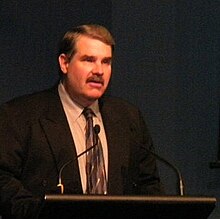
Four main lines of evidence support attribution of recent climate change to human activities: Firstly, a physical understanding of the climate system: greenhouse gas concentrations have increased and their warming properties are well-established. Secondly, there are historical estimates of past climate changes suggest that the recent changes in global surface temperature are unusual. Thirdly, computer-based climate models are unable to replicate the observed warming unless human greenhouse gas emissions are included. And finally, natural forces alone cannot explain the observed warming.

Climate is the long-term weather pattern in a region, typically averaged over 30 years. More rigorously, it is the mean and variability of meteorological variables over a time spanning from months to millions of years. Some of the meteorological variables that are commonly measured are temperature, humidity, atmospheric pressure, wind, and precipitation. In a broader sense, climate is the state of the components of the climate system, including the atmosphere, hydrosphere, cryosphere, lithosphere and biosphere and the interactions between them. The climate of a location is affected by its latitude, longitude, terrain, altitude, land use and nearby water bodies and their currents.

Siegfried Fred Singer was an Austrian-born American physicist and emeritus professor of environmental science at the University of Virginia, trained as an atmospheric physicist. He was known for rejecting the scientific consensus on several issues, including climate change, the connection between UV-B exposure and melanoma rates, stratospheric ozone loss being caused by chlorofluoro compounds, often used as refrigerants, and the health risks of passive smoking.

The instrumental temperature record is a record of temperatures within Earth's climate based on direct measurement of air temperature and ocean temperature, using thermometers and other thermometry devices. Instrumental temperature records are distinguished from indirect reconstructions using climate proxy data such as from tree rings and ocean sediments. Instrument-based data are collected from thousands of meteorological stations, buoys and ships around the globe. Whilst many heavily-populated areas have a high density of measurements, observations are more widely spread in sparsely populated areas such as polar regions and deserts, as well as over many parts of Africa and South America. Measurements were historically made using mercury or alcohol thermometers which were read manually, but are increasingly made using electronic sensors which transmit data automatically. Records of global average surface temperature are usually presented as anomalies rather than as absolute temperatures. A temperature anomaly is measured against a reference value. For example, a commonly used baseline period is the time period 1951-1980.

There is a strong scientific consensus that the Earth has been consistently warming since the start of the Industrial Revolution, and the rate of recent warming is largely unprecedented. This warming is mainly caused by the rapid increase in atmospheric carbon dioxide (CO2) since 1750 from human activities such as fossil fuel combustion, cement production, and land use changes such as deforestation, with a significant supporting role from the other greenhouse gases such as methane and nitrous oxide. This human role in climate change is now considered "unequivocal" and "incontrovertible".

Michael Evan Mann is an American climatologist and geophysicist. He is the director of the Center for Science, Sustainability & the Media at the University of Pennsylvania. Mann has contributed to the scientific understanding of historic climate change based on the temperature record of the past thousand years. He has pioneered techniques to find patterns in past climate change and to isolate climate signals from noisy data.
Thomas R. Karl is the former director of the National Oceanic and Atmospheric Administration’s National Centers for Environmental Information (NCEI). He joined the National Climate Centre in 1980, and when that became the National Climatic Data Center, he continued as a researcher, becoming a Lab Chief, Senior Scientist and ultimately Director of the Center. When it merged with other centers to become NCEI in 2015, he became its first director. He retired on 4 August 2016.

Kevin Edward Trenberth worked as a climatologist at the Climate Analysis Section at the US NCAR National Center for Atmospheric Research. He was appointed Distinguished Scholar at NCAR in 2020. He is also an honorary faculty member in the Physics Department at the University of Auckland, New Zealand. He was a lead author of the 1995, 2001 and 2007 IPCC Scientific Assessment of Climate Change and served on the Scientific Steering Group for the Climate Variability and Predictability (CLIVAR) program.

The Heartland Institute is an American conservative and libertarian public policy think tank known for its rejection of both the scientific consensus on climate change and the negative health impacts of smoking.

Christopher William "Chris" Landsea is an American meteorologist, formerly a research meteorologist with the Hurricane Research Division of the Atlantic Oceanographic and Meteorological Laboratory at NOAA, and now the Science and Operations Officer at the National Hurricane Center. He is a member of the American Geophysical Union and the American Meteorological Society.

Climate change denial is pseudoscientific dismissal or unwarranted doubt that contradicts the scientific consensus on climate change. Those promoting denial commonly use rhetorical tactics to give the appearance of a scientific controversy where there is none. Climate change denial includes doubts to the extent of how much climate change is caused by humans, its effects on nature and human society, and the potential of adaptation to global warming by human actions. To a lesser extent, climate change denial can also be implicit when people accept the science but fail to reconcile it with their belief or action. Several social science studies have analyzed these positions as forms of denialism, pseudoscience, or propaganda.

DeSmog, founded in January 2006, is a journalistic and activist website that focuses on topics related to climate change. The site was founded, originally in blog format, by James Hoggan, president of a public relations firm based in Vancouver, British Columbia, Canada.
The New Zealand Climate Science Coalition was a anthropogenic climate change denial organisation in New Zealand, formed in 2006 with aim of "refuting what it believes were unfounded claims about anthropogenic global warming". The Coalition came to prominence in 2010 when it challenged the methodology and accuracy of NIWA's historical temperature records in court. The Coalition lost the case, could not afford to pay costs awarded against it and was forced into liquidation. There is an unrelated website called the New Zealand Climate Science Coalition which is an American blog also written by climate change deniers. The American website links to a different URL to the original URL associated with the New Zealand website which no longer exists.

The history of the scientific discovery of climate change began in the early 19th century when ice ages and other natural changes in paleoclimate were first suspected and the natural greenhouse effect was first identified. In the late 19th century, scientists first argued that human emissions of greenhouse gases could change Earth's energy balance and climate. The existence of the greenhouse effect, while not named as such, was proposed as early as 1824 by Joseph Fourier. The argument and the evidence were further strengthened by Claude Pouillet in 1827 and 1838. In 1856 Eunice Newton Foote demonstrated that the warming effect of the sun is greater for air with water vapour than for dry air, and the effect is even greater with carbon dioxide.
The Climatic Research Unit email controversy began in November 2009 with the hacking of a server at the Climatic Research Unit (CRU) at the University of East Anglia (UEA) by an external attacker, copying thousands of emails and computer files to various internet locations several weeks before the Copenhagen Summit on climate change.
Watts Up With That? (WUWT) is a blog promoting climate change denial that was created by Anthony Watts in 2006.

Berkeley Earth is a Berkeley, California-based independent 501(c)(3) non-profit focused on land temperature data analysis for climate science. Berkeley Earth was founded in early 2010 to address the major concerns from outside the scientific community regarding global warming and the instrumental temperature record. The project's stated aim was a "transparent approach, based on data analysis." In February 2013, Berkeley Earth became an independent non-profit. In August 2013, Berkeley Earth was granted 501(c)(3) tax-exempt status by the US government. The primary product is air temperatures over land, but they also produce a global dataset resulting from a merge of their land data with HadSST.

In earth science, global surface temperature is calculated by averaging the temperatures over sea and land.

A global warming hiatus, also sometimes referred to as a global warming pause or a global warming slowdown, is a period of relatively little change in globally averaged surface temperatures. In the current episode of global warming many such 15-year periods appear in the surface temperature record, along with robust evidence of the long-term warming trend. Such a "hiatus" is shorter than the 30-year periods that climate is classically averaged over.
















